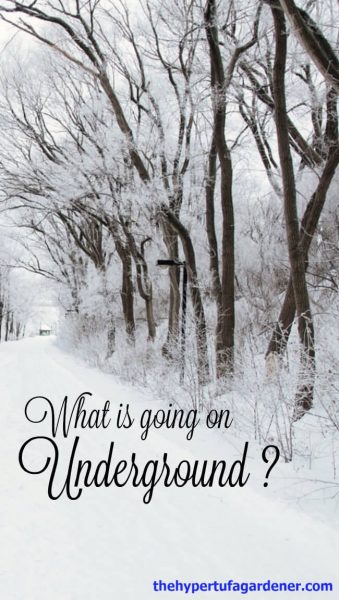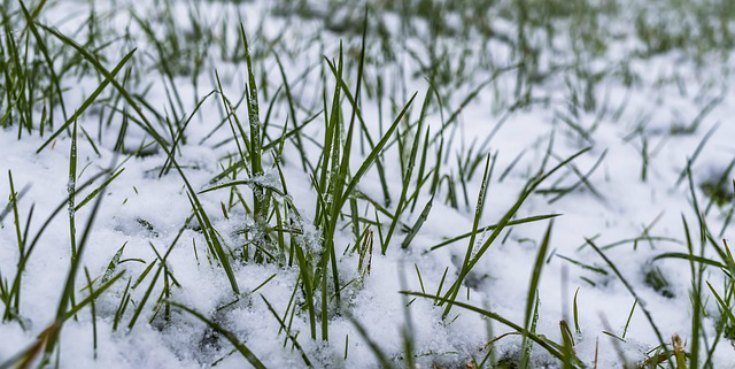What’s Going On Under The Garden Soil?
Ever wonder what’s down there? Under the garden soil?
Like now under the snow? Or all the year for that matter? Is it a deep and cold and dark endless pile of soil and rocks and dinosaur bones, with a few pieces of gold and diamonds and bits of meteors and all that stuff. And a treasure chest full of jewels. Sorry, I am getting carried away. And this reaches all the way to the center of the earth. Well, I guess you would hit that hot center, the core, isn’t that what I learned in science class?
I have been checking this out and it is very interesting. You would probably not be surprised to find out that the soil typically remains at a steady 50º ish. Even if it is 0º outside or if it is 80º, the soil deep underground remains at a steady and even temperature. Hey, I have a basement. And I have been in Mammoth Cave and Ohio Caverns. (Wow it is dark down there when they turn out the lights.)
Of course, the more exposed the surface is, the more likely temperatures will fluctuate in the upper layers of the underground. That is why a covering of mulch gardeners put down after the ground freezes helps to keep the soil from extremes. But even trees, bushes, and lawns keep the temperatures underground on a more even course.

The blanket of snow is a garden soil insulator
But underground, as deep as about six feet, temperatures remain even at around 50º. I guess that is why geothermal energy to heat and cool your home is gaining more popularity. After all, it is a renewal source of energy because the earth isn’t going anywhere…..right?
Deep down under that winter soil, the plant’s roots, along with earthworms and fungi, and microscopic bacteria still are biologically active. These microorganisms will work in the soil all winter long, with fluctuating activity based on the temperature levels. A warm sun hitting the southern exposure of your garden will heat those areas and therefore, there will be increased activity below the surface.
Of course, your hypertufa planters or stone planters are affected more by the fluctuations, but the warming sun can keep the hypertufa containers a bit warmer than if they were plastic or resin. My stone-look planters made with hypertufa do very well.
These hypertufa pots are good for container gardening because of their capabilities of offering good drainage. Water getting into the soil flows slower through the soil in colder temperatures, staying on the plant’s roots for longer periods of time. Most plants can tolerate a little wetness in winter due to their own slowing metabolism. But some plants cannot live in damp soil through the winter and their loss or damage is usually due to the poor drainage. Maybe you should try those plants in a raised bed or even a large hypertufa planter so it gets the drainage it needs to survive.

I have a large area in my back yard now ( where we removed a pool) and it’s just a large patch of brown earth and patches of grass and weeds. We are throwing mulched leaves on the area and letting nature takes its course and hopefully by next spring, the ground will be ready for seed. We had made progress and had some green back there, but then it was all trampled and torn up again when we had our trees removed.
So during this winter, the freezing and thawing of the soil surface will help break up the compacted and trampled surface for us. The water in tiny crevices on the surface will freeze and those growing ice crystals will push and shove as they expand and contract. The result is a crumbly soil that just needs to be raked a little bit to smooth it over so that it is ready for the seed. And what seed should I plant? I will need to study up on that one!
One good thing that I have heard is that the roughness of the soil surface will help it resist erosion by severe winter downpours of rain. I would rather it hold snow and stay put than wash away down the slight incline we have. The snow carries nitrogen from the atmosphere and that will be needed by a newly sprouting lawn in the spring.
I am hopeful that we have a good winter ( as my woolly bear caterpillars predicted ) and that all my hypertufa planters survive. I love my garden full of stone planters and look forward to making hypertufa in the garage this winter. ( I am driving my husband crazy…but it’s a short trip. LOL!)
I am not looking forward to a icy and snowy winter, are you?


